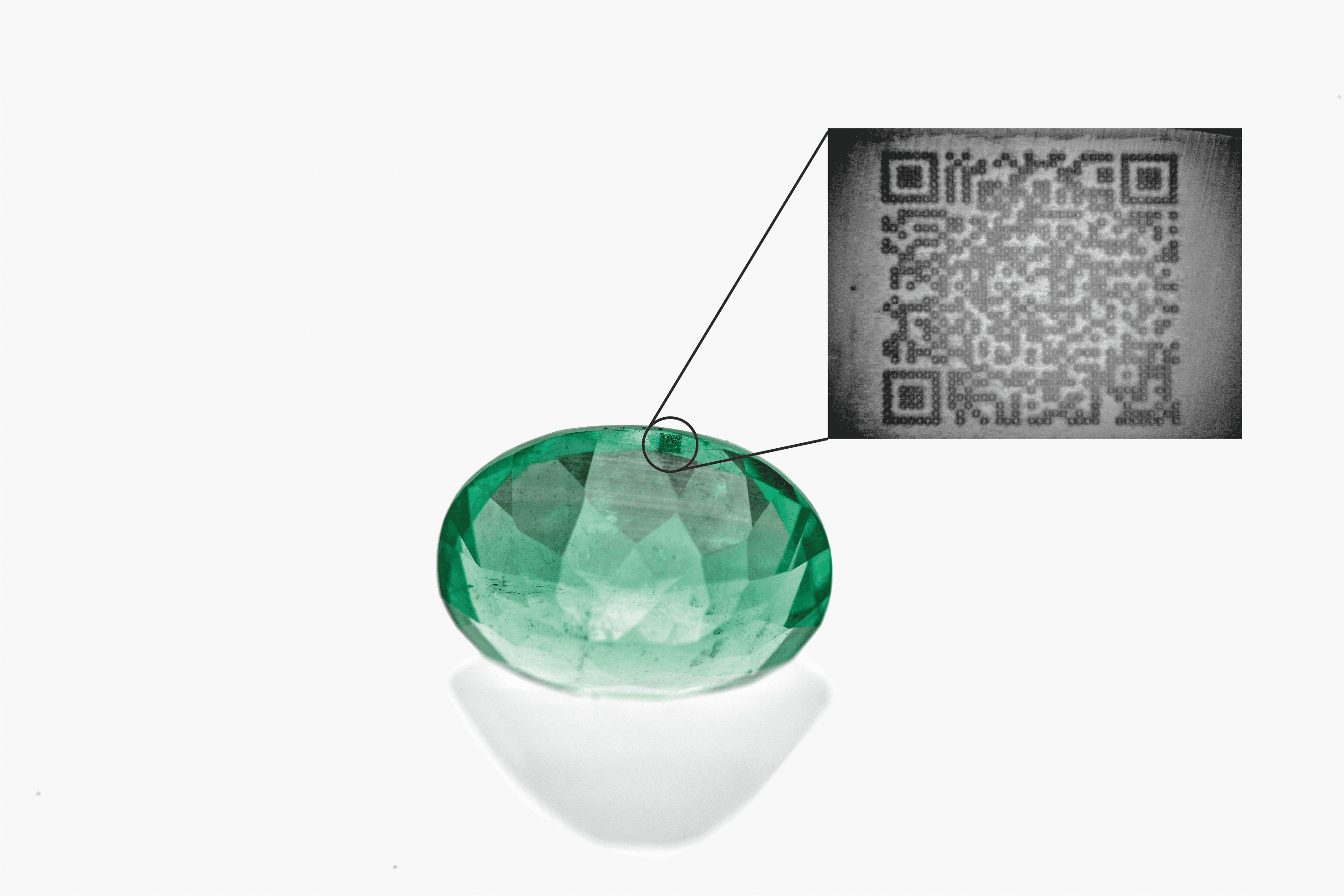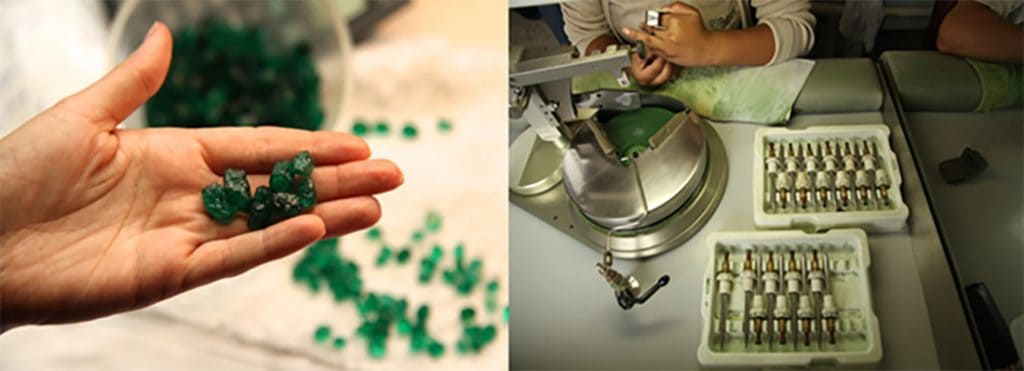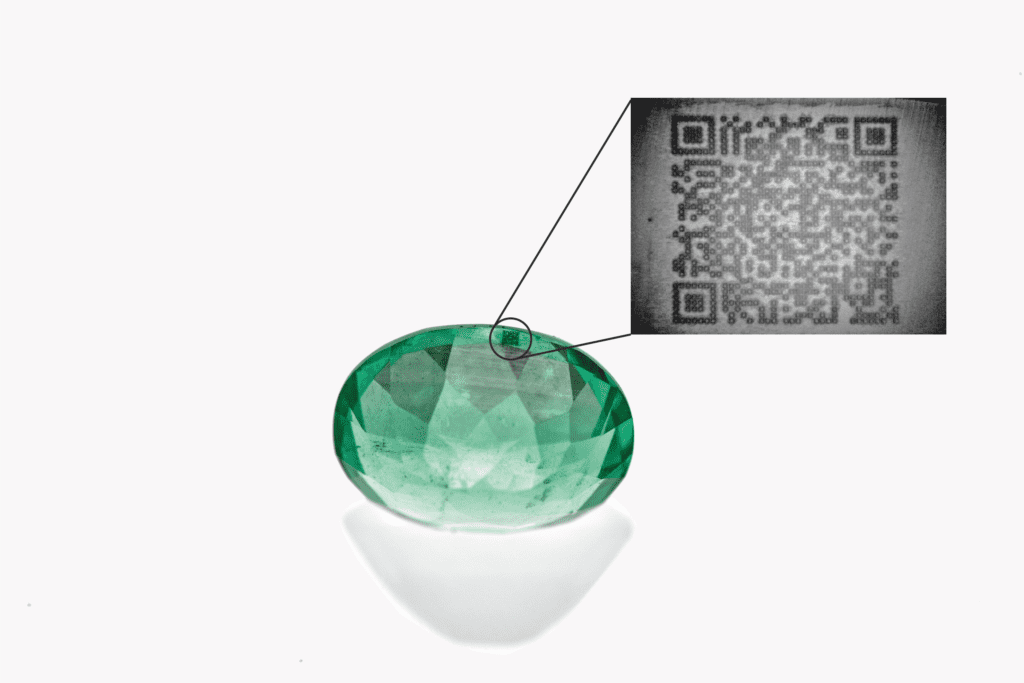
Traceability and Blockchain for Gemstones – an Overview

by Dr. L. E. Cartier first published in Facette 25 (February 2019)
Recent developments have brought‚ due diligence, along with tracking and traceability, to the forefront of discussions and requirements in the diamond, coloured stone and pearl industries. To address this trend, certification mechanisms and technologies (such as blockchain) are being developed to solve inherent traceability challenges. As applied to gems, such standards and associated technology could benefit from the support of existing gemmological approaches (e.g. geographical origin determination) to enhance traceability and transparency measures. This article seeks to provide the reader with an overview of current developments, terms used in this context and the research SSEF is carrying out in this regard.
Diamond – in the context of conflict diamonds and the Kimberley Process Scheme (KPCS)- is not the only mineral or metal used in jewellery supply chains that has been scrutinised in recent years: for example, there has been a focus on gold (Dirty Gold campaign in 2004 and Conflict Gold in 2012), rubies and jade from Myanmar, lapis lazuli from Afghanistan or precious corals listed under CITES to name a few notable cases. In response to these developments, jewellery industry associations (e.g. CIBJO, WDC, ICA, AGTA) have begun to address these issues and groups have gone on to form a range of initiatives to strengthen responsible practices in the industry, such as CIBJO’s responsible sourcing blue book or the Responsible Jewellery Council (RJC).
Why traceability? Why now?
As in other sectors (e.g. food, fashion, shipping), there is now greater demand for specific information on how the raw materials leading to finished pieces of jewellery are extracted and processed. Traceability is one way to provide more transparency and specific information, and it is frequently argued that by increasing transparency, supply chain issues can be better mapped and understood. Blockchain and other traceability tools are being heralded by some as solutions to transform the jewellery industry, others disagree. As the October 2018 Emerald World Symposium and CIBJO Congress in Bogotá (Colombia) showed; ‘blockchain’, ‘due diligence’, ‘responsible sourcing’ and ‘traceability’ were very widely discussed topics.
At present there are a number of factors shaping the development of responsible practices and the move for increased traceability and transparency in the jewellery industry, and more specifically for diamonds
and coloured gemstones:
• Consumers are increasingly interested in knowing where and how the gemstones and jewellery they purchase are mined and manufactured.
• Media and NGOs are placing the gem and jewellery industry under increased scrutiny regarding the origin and sustainability footprint of various gemstones and human rights issues in the artisanal mining sector.
• Some companies want to be proactive so as to mitigate risks and better understand their own supply chains and contribute to positive outcomes.
• Governments want to improve the management and revenue collected from gem resources.
• Global governing bodies have highlighted issues such as smuggling and money laundering.
• Some governments (e.g. USA, EU) have instituted ‘conflict mineral’ legislation, requiring publicly traded companies to know and trace their supply chains and comply with their laws.
Traceability is often understood to mean an object is fully traceable (i.e. an individual gem is uniquely documented and identifiable at each step of the supply chain from mine to market), but there are other models of product traceability. Traceability information could be used as:
• a tool for supply chain management (managing and locating stock)
• demonstrate compliance (against given standards or legal requirements) and support due diligence
• provide evidence of provenance and/or sustainability claims
As best practices and standards within mining, processing and sale of gemstones are increasingly defined worldwide – the development of techniques to track and trace gemstones may support the accountability of such schemes and may even become necessary for example for publicly listed companies to demonstrate compliance to specific government regulations. Importantly, the Organisation for Economic Cooperation and Development (OECD) developed due diligence guidelines for responsible mineral supply chains for companies seeking to respect human rights and avoid contributing to conflict through their mineral sourcing decisions and practices; these guidelines now apply to all minerals, including diamonds and coloured gemstones.
Translating terms
As recent conferences and events suggest, there is some confusion around the terms used surrounding traceability and responsible sourcing. As such in a recent article we sought (Cartier et al., 2018 and references therein) to define and contextualize these terms to provide clarity to members of the trade. These terms include:
Chain of custody: “The document trail recording the sequence of companies and individuals that have custody of minerals as they move through a supply chain.”
Due Diligence: “The act of proactively ensuring that the products sourced and traded by companies within a supply chain conform to national and international regulations.”
Disclosure: The release of information by companies required by regulators or requested by business partners in the supply chain.
Provenance: A (documented) claim made on the origin (e.g. country or mine), source (e.g. recycled, mined, artisanally mined, natural, synthetic), previous ownership (e.g. a historic gemstone or a piece of jewellery formerly in a royal collection) or extraction and processing practices (e.g. conflict free, untreated, responsibly sourced).
Traceability: “The ability to identify and trace the history, distribution, location, and application of products, parts, and materials” (ISO)
Tracing: The use of traceability records or an object’s properties to identify the origin, attributes or history of a product within the supply chain (i.e. from market to mine). This could include origin determination using gemmological science.
Tracking: The use of traceability records to track an item from its origin to the end consumer through the supply chain (i.e. from mine to market). This is often complemented by the use of tracking technology such as radio-frequency identification (or RFID) chips, near-field communication, synthetic DNA implantation, barcodes or other forms of tagging.
Blockchain- a silver bullet for the industry?

There has been considerable hype around blockchain in recent times with radical promises made of how it could disrupt and transform entire industries. Blockchain is a decentralized and immutable ledger, which is the basis for the potentially huge transparency gain that this technology can offer. At each step, data added to the blockchain are verified, ownership is attributed, and the information is time stamped, encrypted, and stored permanently in a distributed and decentralized manner, providing an immutable record that is formed of a single, yet shared, source of information about a gemstone’s journey from source to end consumer.
Blockchain can thus provide transparency and verification to the regulators and other users who require it, while still providing the privacy and the specific views into the ledger that are relevant for each different type of user. This is an important factor for the gem and jewellery industry, which demands verified, but often anonymized, chain-of-custody solutions. The prospect of combining blockchain with smart contracts (automatic trades and verification between accounts/ users if pre-required conditions are met) can potentially provide a huge gain in efficiency (especially with regards to demonstrating compliance and know-your-customer procedures), and they are one of the main reasons why blockchain is being widely investigated as a game-changing technology.
Diamond miner De Beers launched the Tracr blockchain in 2017 to track diamonds through the full value chain. The Trustchain Initiative (piloted by IBM) is an industry collaboration to pilot traceability using blockchain in diamond and gold jewellery from mine to retailer. Finally, Gübelin and Everledger are piloting a blockchain for coloured gemstones that is due to be launched in 2019.
Traceability for gems is nothing new: the role of gemmology
As the science of gemmology emerged in the early 20th century, and synthetics and treatments became critical research issues, interest grew in carrying out structured investigations on gem materials from different origins to better characterise their properties. For example, Chesley in 1942 attempted to correlate spectroscopic features of diamonds to their source localities. Geographical origin determination of coloured stones as we know it today appeared in the 1980s, and at the beginning focused on characterisation of typical microscopic inclusions from a deposit. This was subsequently complemented by chemical and spectroscopic work on gem materials from various localities, such as the early work on Kashmir sapphires by Prof. Henry Hänni of SSEF.
Origin determination of gems today is an expert scientific opinion on the origin (country) of a stone, based on characteristic inclusions and chemical and spectroscopic features. Although it is not possible to trace a coloured stone back to a specific mine, origin determination can help validate claims made by companies regarding country of origin. Importantly, gemmological science can continue to provide much-needed assistance regarding claims of origin (geographical and whether a gem is natural or synthetic) and whether or not a gem has been treated. A gem’s inclusions and their location within the stone can be used to help verify its identity, as well as provide gemmological data that can later be compared to existing chain-of-custody information.
Building on our gemmological expertise we are pleased to announce the launch of our new GemTrack service early 2019 (see article Page 44). A GemTrack document links a cut stone to a specific rough stone using gemmological techniques. GemTrack is based on a combination of crystallographic, structural, chemical and microscopic analyses that allow for detailed and potentially unique characterisation and fingerprinting of a rough stone. These same features are later investigated in the cut stone, following the cutting and polishing process, enabling us to confirm and gemmologically track the journey of a stone.
Technology and traceability- what’s next?
As blockchain is a nascent concept in other sectors too, it is unclear whether industry-wide consensus is possible or necessary at this stage. Fundamentally, for a gem and jewellery industry that consists largely of cottage and family-owned companies, further research is needed to understand how all levels of the supply chain can benefit from traceability opportunities that blockchain technology provides. The current focus on full mine-to-market traceability may not be as realistic as it has been shown for other sectors, nor may the market necessarily want or require it.
The fragmented nature of some parts of the gem industry makes traceability a complex and challenging undertaking. Sorting and aggregation steps in supply chains—in which goods may be sorted in terms of quality rather than origin—may further complicate this endeavour. Regulatory requirements and consumer demands for supply chain integrity and knowledge of provenance will continue to push the industry to find solutions. This may also provide newfound opportunities if, for example, synthetics and treated stones can be separated more clearly from natural/untreated material in the supply chain based on traceability information to verify the ownership and authenticity of gem materials at different stages of the supply chain.
In summary, there is no ‘silver bullet‘ for traceability or improving practices in the diamond and gemstone supply chains. Ultimately, multiple approaches, initiatives and technologies are likely to spur greater transparency and provide more sustainable outcomes in the industry.




